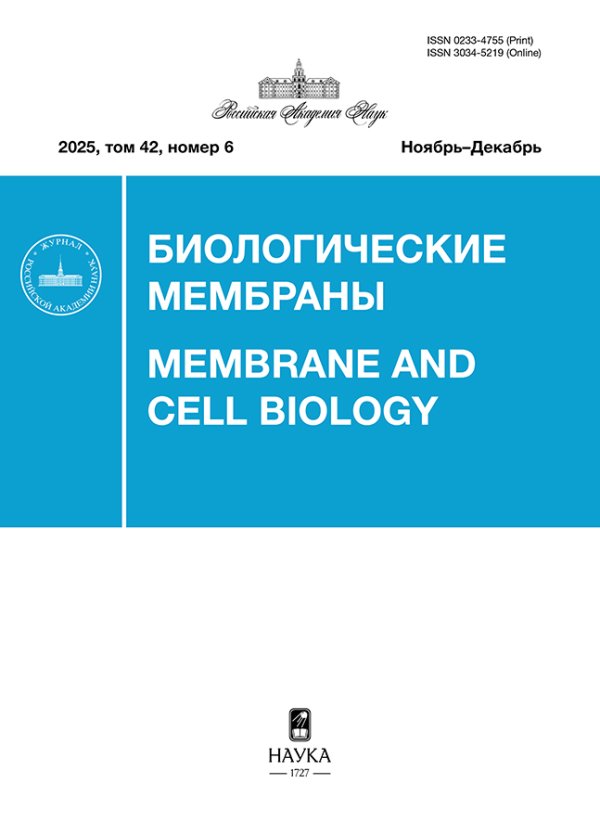Vol 40, No 1 (2023)
ОБЗОРЫ
The Role of Lipid Domains and Physical Properties of Membranes in the Development of Age-Related Neurodegenerative Diseases
Abstract
A growing number of studies indicate the relationship between the development of neurodegenerative diseases and the structure and lipid composition of neuronal membranes. One of the structural elements of cell membranes, which in this regard attracts special attention, are liquid-ordered lipid domains, or rafts. The study of rafts and age-related changes in the lipid composition of neuronal cells is becoming increasingly relevant and is constantly being updated. In this review, we tried to highlight the possible role of the lipid component of cell membranes, their structure, and physicochemical characteristics in the development of diseases associated with aging. The reviewed evidence supports the possible role of rafts in diseases, which lead to disruption of the functioning of neurons over a long period of time. There is reason to believe that the therapeutic effects of various molecules, such as lysolipids and gangliosides, are due to their physicochemical properties and are realized indirectly, through their influence on the organization of lipid domains in membranes. As the role of lipid domains and, in general, the mechanisms of interaction and mutual influence of lipid composition and disease development are more fully understood, this knowledge can be used to develop new therapeutic or preventive methods to combat diseases associated with aging.
 3-18
3-18


Mechanosensitive Channels: History, Diversity, and Emerging Mechanisms
Abstract
Mechanical forces are inseparable from most cellular functions. Cell division, contraction and adhesion generate intrinsic forces in the cells, whereas perturbations in the environment such as osmotic shifts, mechanical pressure, shear or sound represent the external forces that the cells gauge and respond to. Mechanosensitive (MS) ion channels, which are the fastest mechanotransducers, represent a polyphyletic group with vastly diverse structural designs. In this review we briefly outline the history of the field by presenting major findings in a nearly chronological order, describe structural features of different groups and attempt to illustrate some common physical principles of their gating mechanisms.
 19-42
19-42


Articles
Cell Lines with a Single Functional Isoform of the IP3 Receptor
Abstract
Many agonists regulate cellular functions through surface receptors coupled by the phosphoinositide cascade to Са2+ mobilization. In unexcitable cells, the generation of Са2+ signals relies largely on Са2+ release from из Са2+ store localized in the endoplasmic reticulum (ER). In this system, IP3 receptors (IP3Rs), which are intracellular IP3-gated Са2+- channels, mediate controllable Ca2+ release from Ca2+ store in response to cell stimulation. A variety of factors embarrass both the analysis of a specific role for IP3Rs in cell physiology and detailing their regulatory mechanisms. Firstly, three genes encode IP3Rs, while cells usually express two or even all of them. Moreover, different IP3R isoforms are under control of distinct mechanisms. Yet, isoform-specific antagonists of IP3Rs have not been identified yet. Cell lines that express a single isoform appear to be an effective cellular model for studying regulatory mechanisms, pharmacology, and physiological role of I-P3R subtypes. Here we employed the CRISPR/Cas9 technology to inactivate genes of IP3Rs in cells of the HEK-293 line, which express all three isoforms. Several monoclones of genetically modified HEK-293 were obtained, and those containing biallelic inactivation mutation in two IP3R genes were identified. Finally, three monoclonal cell lines, each containing the only functional IP3R isoform, were generated. These cellular models can be used to evaluate a role for IP3R of a particular subtype in agonist-induced Ca2+ signaling as well as for the analysis of their regulatory mechanisms.
 43-54
43-54


Two Types of Cellular Serotonin Biosensors
Abstract
The method of cellular biosensors, which allows local detection of substances secreted by single cells, is traditionally used for studying the peripheral taste system. This method is based on cells that can detect secreted molecules with surface receptors coupled to the mobilization of intracellular Ca2+. Thus, the neurotransmitter release can be tracked on-line by Ca2+ signals generated by a cell-biosensor. A specific feature of such cellular biosensors is that Са2+ signals induced by GPCR ligands may be generated in the “all-or-nothing” manner due to the involvement of trigger-like mechanism, that is Ca2+-induced Ca2+ release (CICR). Although such a sensor validates the fact of neurotransmitter secretion, it does not allow studying regulatory circuits controlling the quantity of the released substance. This implies that biosensors, which are based on distinct intracellular signaling pathways, such as for cAMP signaling, could be more informative. Here we generated two types of serotonin biosensors. One was based on CHO cells expressing the recombinant 5-HT2C receptor coupled by the phospholipase pathway to Ca2+ mobilization. Another involved HEK-293 cells that expressed both 5-HT2C receptor coupled to adenylyl cyclase and the fluorescent protein Pink Flamindo serving as genetically encoded cAMP sensor. Although both cellular biosensors allow detection of nanomolar serotonin, 5-НТ2С cells generated Ca2+ responses in the “all-or-nothing” manner. In contrast, in 5-HT4 and Pink Flamindo expressing cells, serotonin-triggered cAMP responses gradually rose with agonist concentration in the range of 0.3–30 nM. It thus appears that the 5-НТ4/Pink Flamindo biosensor is suitable for studying regulatory mechanism of serotonin secretion.
 55-60
55-60


Production of Reactive Oxygen Species by Genetically Encoded Photosensitizers 4D5scFv-miniSOG and DARPin-miniSOG in Living Cells
Abstract
Currently, experimental oncology is developing approaches based on the development of targeted photosensitizers that can be delivered specifically to a tumor of a certain molecular profile. This work is devoted to the study of the generation of reactive oxygen species by photosensitizers of protein nature 4D5scFv-miniSOG and DARPin-miniSOG, specific to the oncomarker HER2. It was found that despite the presence of the same phototoxic module in their composition, these photosensitizers are characterized by different levels of ROS production, which may be explained by the different rate of receptor-mediated internalization of 4D5scFv-miniSOG and DARPin-miniSOG.
 61-65
61-65


Targeting Liposomes Loaded with DNA Mimetics for the Directional Elimination of Tumor Cells
Abstract
The article presents an innovative method for the targeted elimination of tumor cells of a certain molecular profile by inactivating the transcription of genes of common subunits of human RNA polymerases using complementary DNA mimetics delivered into cells inside liposomes modified on the outer surface with targeting molecules. It was shown that inactivation of genes of RNA polymerase common subunits Rpb5, Rpb6, or Rpb8 by the proposed method, depending on the chosen target, causes death of up to 50% of HER2-positive human breast cancer cells in culture.
 66-70
66-70


Effect of Auxin on Fatty Acid Composition and Activity of Acyl-Lipid Desaturases in Sprouts of Spring Wheat Triticum aestivum L.
Abstract
The effect of exogenous auxin on the fatty acid composition of total lipids in leaves and roots of spring wheat seedlings (Triticum aestivum L.) was studied. It has been established that the diversity of fatty acids in vegetative organs (leaf or root) depends not only on the concentration of auxin, but also on the nitric oxide donor (N2, NO3). It was noted that increasing the concentration of exogenous auxin increased microviscosity and decreased the permeability of the membranes of the vegetative organ in wheat, which was accompanied by a decrease in the double bond index. At the same time, there is an increase in the concentration of saturated fatty acids (palmitic and stearic), which are used as precursors for the formation of fatty acids with a very long chain (VLCFA). It was shown that exogenous auxin leads to an increase in the total content of VLCFAs in leaves with a deficiency (8.4%) and an excess of NO donors (12.3%). The introduction of exogenous auxin eliminates significant differences in the activity of desaturases in wheat roots at different levels of nitric oxide donors. It is suggested that the biosynthesis of docosadienoic acid (C22:2) in leaves is one of the key stages in the formation of an adaptive response of cell membranes to abiotic stresses during plant ontogenesis. An increase in the level of NO promotes the movement of auxin from roots to shoots, which can serve as a regulator of the activity of elongases and desaturases during the synthesis of VLCFAs.
 71-80
71-80












